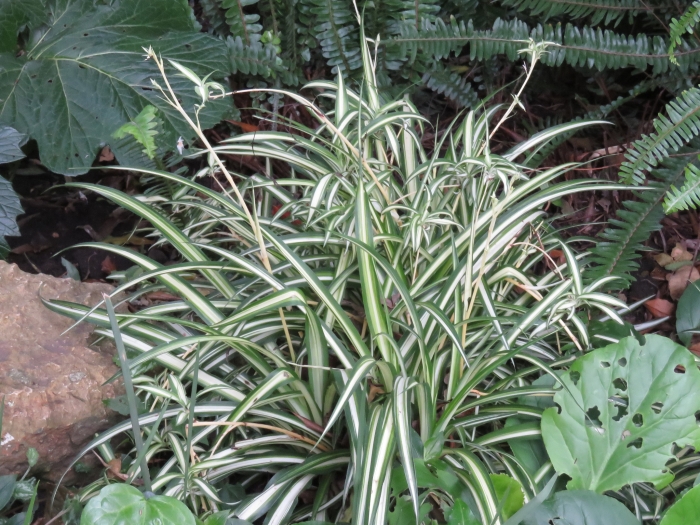Spider Plant
(Chlorophytum comosum)
Spider Plant (Chlorophytum comosum)
/
/

© Juan Carlos Caicedo Hernández
CC BY 4.0
Image By:
© Juan Carlos Caicedo Hernández
Recorded By:
Copyright:
CC BY 4.0
Copyright Notice:
Photo by: © Juan Carlos Caicedo Hernández | License Type: CC BY 4.0 | License URL: http://creativecommons.org/licenses/by/4.0/ | Uploader: juan_carlos_caicedo_hdz | Publisher: iNaturalist |














































Estimated Native Range
Summary
Chlorophytum comosum, commonly known as Spider Plant, is an evergreen perennial herb native to tropical and southern Africa, where it is found in the understory of forests and along the margins of clearings. It typically grows to about 60 cm (24 in) tall and is known for its arching leaves and cascading growth habit, making it ideal for hanging baskets. The Spider Plant produces fleshy, tuberous roots, each about 5–10 cm (2–4 in) long. Its inflorescences bear clusters of small, greenish-white flowers, which are relatively sparse after the initial bloom. The plant is appreciated for its air-purifying qualities and is often used in indoor settings for its ability to tolerate low light conditions.
Spider Plants are favored for their ease of maintenance and adaptability to a wide range of indoor environments. They are tolerant of a variety of temperatures, though they prefer a range between 18 °C (65 °F) and 32 °C (90 °F). They are susceptible to damage from high fluoride or boron levels in water, which can cause leaf tip burn. Spider Plants are commonly used as houseplants and are popular for their variegated foliage and the production of plantlets, or ’spiderettes’, which dangle from the mother plant on long stems. These plantlets can be easily propagated by potting them directly into soil. In cultivation, Spider Plants perform best in part shade to full shade with medium water requirements and well-draining soil. They are not known for aggressive roots or significant disease problems, making them a low-maintenance choice for gardeners.CC BY-SA 4.0
Spider Plants are favored for their ease of maintenance and adaptability to a wide range of indoor environments. They are tolerant of a variety of temperatures, though they prefer a range between 18 °C (65 °F) and 32 °C (90 °F). They are susceptible to damage from high fluoride or boron levels in water, which can cause leaf tip burn. Spider Plants are commonly used as houseplants and are popular for their variegated foliage and the production of plantlets, or ’spiderettes’, which dangle from the mother plant on long stems. These plantlets can be easily propagated by potting them directly into soil. In cultivation, Spider Plants perform best in part shade to full shade with medium water requirements and well-draining soil. They are not known for aggressive roots or significant disease problems, making them a low-maintenance choice for gardeners.CC BY-SA 4.0
Plant Description
- Plant Type: Herb
- Height: 1-2 feet
- Width: 1-2 feet
- Growth Rate: Moderate
- Flower Color: N/A
- Flowering Season: Spring, Summer
- Leaf Retention: Evergreen
Growth Requirements
- Sun: Part Shade
- Water: Medium
- Drainage: Medium, Fast
Common Uses
Bee Garden, Groundcover, Low Maintenance, Potted Plant, Street Planting
Natural Habitat
Native to the understory of forests and along the margins of clearings in tropical and southern Africa
Other Names
Common Names: Ribbon Plant, Spider Ivy, Hen And Chickens, Spiderplant, Ampellilja, 吊蘭, 접란
Scientific Names: , Chlorophytum comosum, Anthericum comosum, Chlorophytum sternbergianum, Chlorophytum miserum, Chlorophytum brevipes, Chlorophytum limurense, Chlorophytum kirkii, Cordyline vivipara, Chlorophytum delagoense
GBIF Accepted Name: Chlorophytum comosum (Thunb.) Jacques